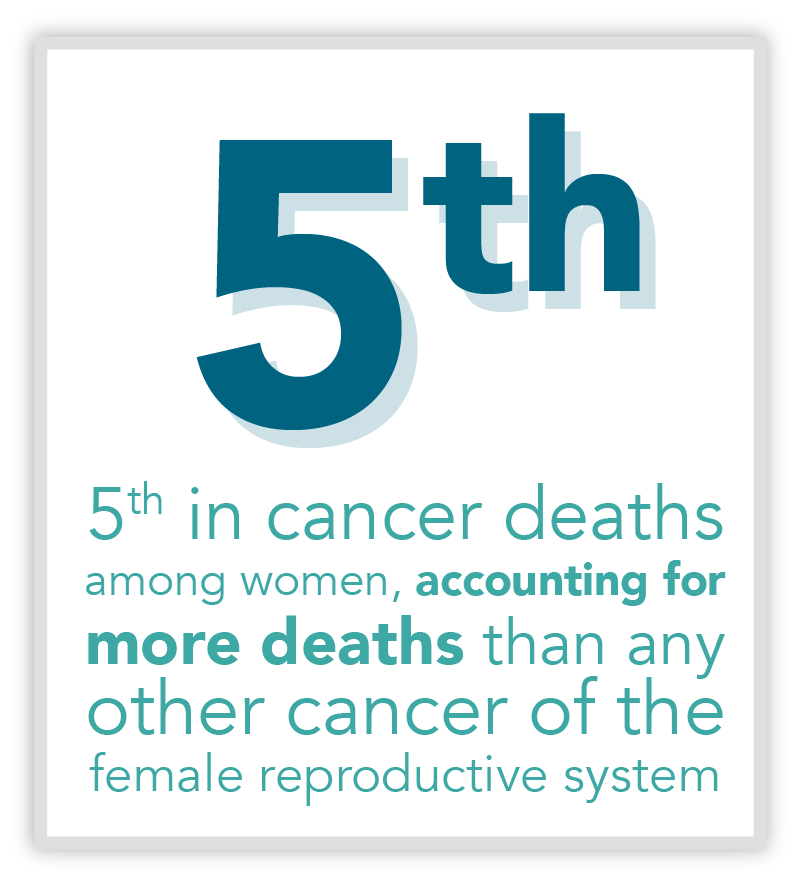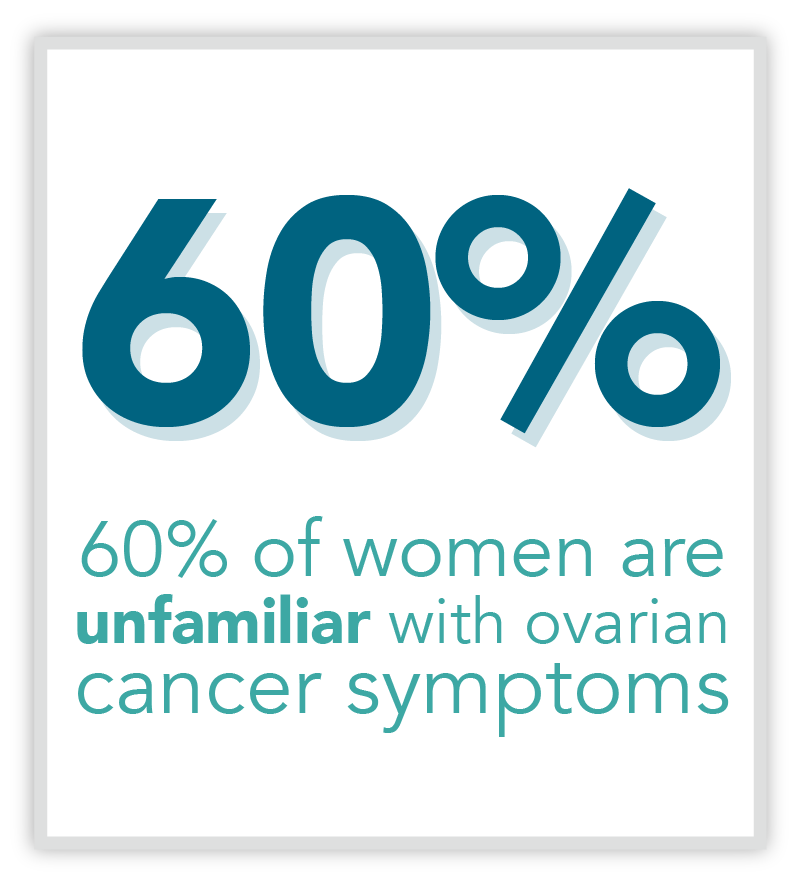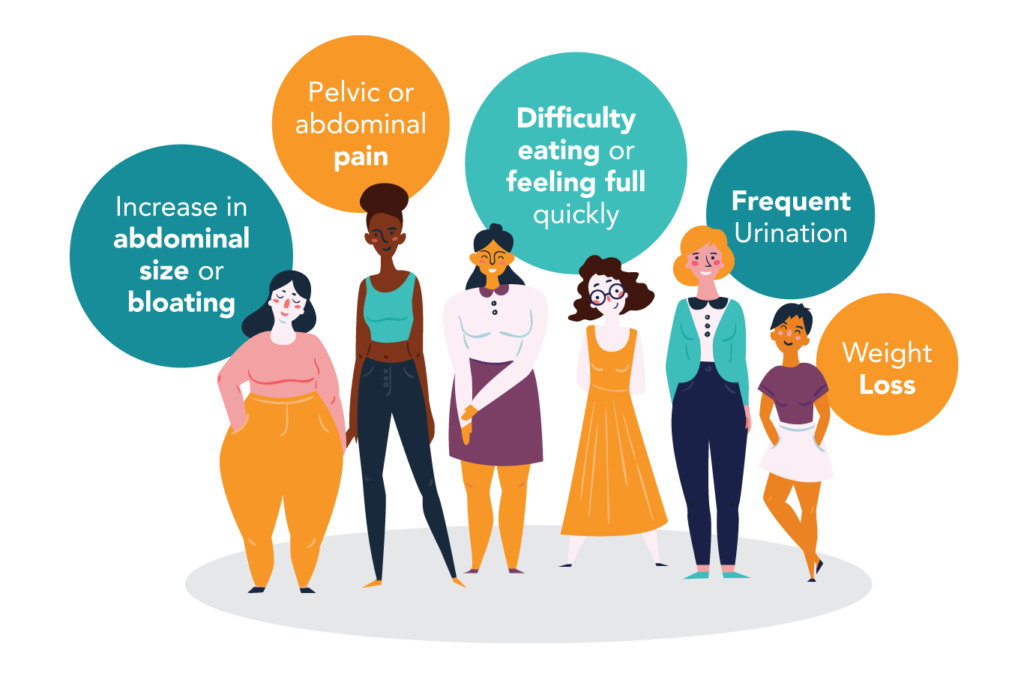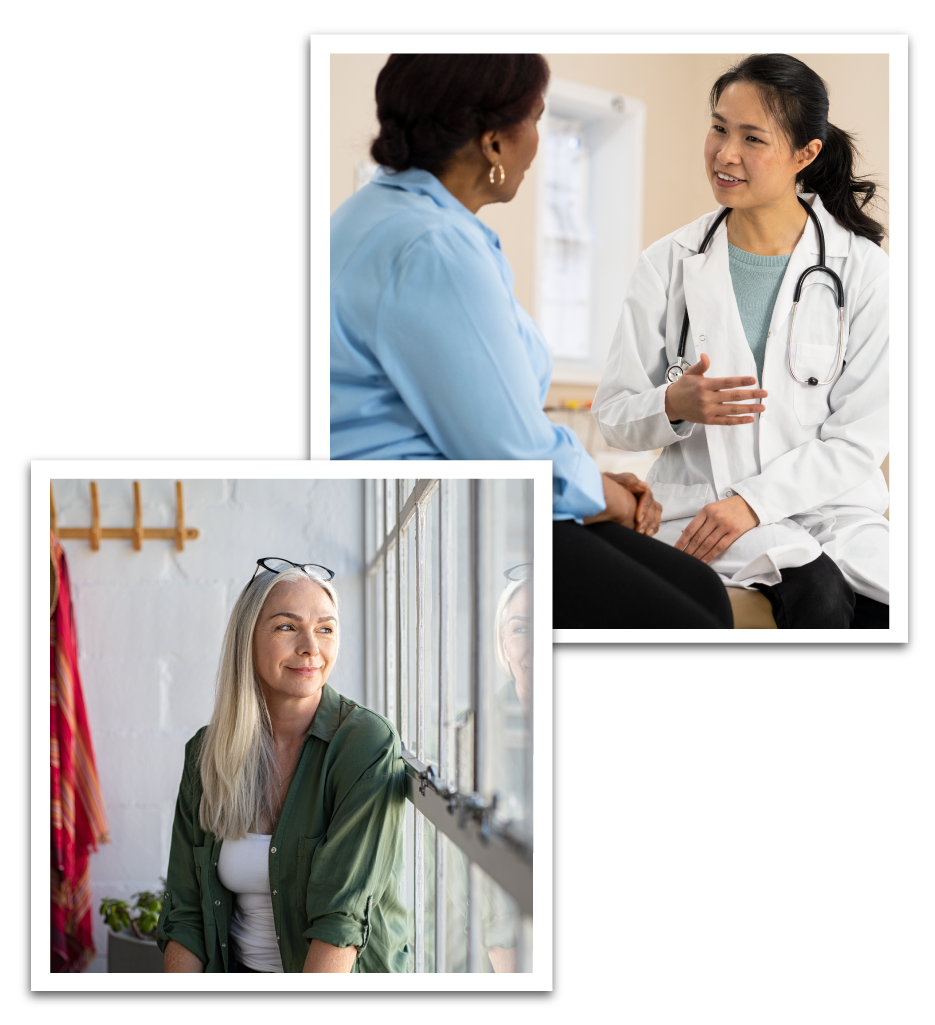What is Ovarian Cancer?
Like all cancers, ovarian cancer represents a change in the normal behavior of the cells within the organ such that they begin to grow and divide uncontrollably. There are approximately 22,000 cases of ovarian cancer (all subtypes) annually in the United States, which accounts for about 3% of all women’s cancers.1
Quick Facts About Ovarian Cancer



Types of Ovarian Cancer2
Ovarian cancers are named after the types of cells of the ovaries that become cancers. Though there many types and subtypes of ovarian cancers, most are grouped into one of three categories: epithelial tumors, germ cell tumors, and stromal cell tumors.
Epithelial Cell Tumors
Epithelial tumors start from the cells that cover the outer surface of the ovaries. These are the most common type of ovarian cancerous tumors, accounting for about 80% – 88% of ovarian cancers. Epithelial ovarian cancer is divided into five main subtypes:
- Serous (most common)
- Endometrioid
- Clear Cell
- Mucinous
- Unclassifiable
Stromal Cell Tumors
Stromal tumors, which form from the cells that hold ovaries together and produce female hormones, account for about 5% of ovarian cancer occurances. The most common subtype of stromal cell tumors are granulosa and Sertoli-Leydig cell tumors. Of these, granulosa stromal cell tumors are most common in postmenopausal women.
Germ Cell Tumors
Germ cell tumors, which start from cells that produce ova (the eggs), amount to about 1 – 2% of ovarian cancer cases. This type of ovarian cancer is most common in young women in their late teens and early 20s, and when caught early, germ cell tumors have about a 90% cure rate. The majority of instances of this type of germ cell tumors are benign, though malignant occurances do exist. Some common subtypes include:
- Teratoma
- Dysgerminoma
- Endodermal sinus tumor (EST)
Primary Peritoneal Carcinoma
Primary Peritoneal Carcinoma (PPC) is a rare cancer that affects the cells in the lining of the abdomen. Though PPC is closely related to epithelial cancer and displays similar signs and symptoms, women are still at risk for this cancer even after their ovaries have been removed. This type of cancer is an advanced cancer and is always categorized as either stage 3 or stage 4 during ovarian cancer staging.
Signs and Symptoms3
There are signs and symptoms of ovarian cancer that one can be on the lookout for. The following is a list of signs and symptoms which are associated with an increased risk of ovarian cancer. Having these risk factors however, does not necessarily mean that you have ovarian cancer.
According to the Ovarian Cancer National Alliance, “For years, women have known that ovarian cancer was not the silent killer it was said to be. Over the past decade, science has confirmed what women have long known: ovarian cancer has symptoms.” There are symptoms of ovarian cancer that women should know and look out for. The following is a list of symptoms which are associated with an increased risk of ovarian cancer.

Do you have any Ovarian Cancer Symptoms?
We have created the Goff Symptom Index Questionnaire, answer these three easy questions to help assess your symptoms and talk with your doctor.

Additional risk factors to consider are5:
Genetics4
Women who carry either a BRCA1 or 2 gene have a syndrome known as Hereditary Breast and Ovarian Cancer Syndrome (HBOC). While HBOC constitutes the single largest percentage of Hereditary Ovarian Cancer, it is important to know that HBOC is not the only Hereditary Cancer Syndrome that is associated with Ovarian Cancer. BRCA1 and BRCA2 are the two genes that make up 10 to 15 percent of all ovarian cancers. Eastern European women and women of Ashkenazi Jewish descent are at a higher risk of carrying both genes. Women with the genetic mutations and who have been diagnosed with breast cancer, have an increased risk of ovarian cancer.
Obesity6
Studies have shown that obesity increases a woman’s chances of ovarian cancer diagnosis. Particularly for women who are obese and premenopausal.
Family History8
Over 75% of women who develop ovarian cancer have neither a family history of ovarian cancer, nor a genetic predisposition. A family history of cancer may suggest an inherited risk.
Infertility7
Pregnancy reduces breast and ovarian cancer risk by stabilizing breast tissue, lowering total lifetime exposure to estrogen, and preventing ovulation. Never giving birth, whether by choice or due to infertility, is associated with an increased risk.
Hormone Replacement Therapy8
Doctors may prescribe hormone replacement therapy to alleviate symptoms associated with menopause (i.e. hot flashes, night sweats, vaginal dryness) that occur as the body adjusts to decreased levels of estrogen. Women who use menopausal hormone therapy are at an increased risk for ovarian cancer.
Aging9
The risk of developing ovarian cancer gets higher with age. Ovarian cancer is rare in women younger than 40. About 90 percent of women who get ovarian cancer are older than 40.
Diagnosis and Management10
Tests like OVA1 can help determine the pre-surgical risk and potentially lead to an earlier detection. Ovarian cancer is diagnosed in surgery. When ovarian cancer is found, the malignant tumor is removed and likely to be followed up with chemotherapy treatments. The survival rate of ovarian cancer depends on if and how extensively the cancer has spread beyond the ovaries. Finding ovarian cancer at an early stage can lead to a much higher success rate in treatment. Unfortunately, ovarian cancer often goes undetected until it has spread and becomes more difficult to treat.
A specialist may perform the following surgical interventions for ovarian cancer:
- Tissue biopsy (examine for cancer under the microscope)
- Ovarian Cancer Staging (to understand how / if the cancer has spread)
- Cytoreduction (remove as much ovarian cancer as possible)

What is Ovarian Cancer Staging?11
Staging is the process used to determine how widespread a cancer is and represents a critical step in diagnosis. Typically staging is done during surgery when tissue samples are collected to find out if cancer is present and where. Ovarian cancer is categorized in four stages:
| Stage | Descriptions | Incidence | 5-Year Survival |
|---|---|---|---|
| Stage 1 – Tumor is confined to the ovaries | Confined to the ovary | 23% | 90% |
| Stage II – Tumor involves one or both ovaries and has spread within the pelvis | Extends to true pelvis | 13% | 80% |
| Stage III – Tumor involves one or both ovaries and has spread outside of the pelvis or to the lymph nodes | Extends beyond true pelvis | 47% | 15-20% |
| Stage IV – Tumor involves the ovaries and has spread to other organs outside of the pelvis | Distant Disease | 16% | <5% |
Ovarian Cancer's Survival Rate12
The survival rate for ovarian cancer is dependent on the type of cancer found and the stage in which it was discovered. Women diagnosed at an early stage (Stage I), before the cancer has spread, have a much higher survival rate than those diagnosed at a later stage. Many other factors, including age, general health, and how well the cancer responds to treatment will have an effect on survival rate.
The survival rate for ovarian cancer is dependent on the type of cancer found and the stage in which it was discovered. Women diagnosed at an early stage (Stage I), before the cancer has spread, have a much higher survival rate than those diagnosed at a later stage. Many other factors, including age, general health, and how well the cancer responds to treatment will have an effect on survival rate.

- American Journal of Obstetrics & Gynecology, The role of the fallopian tube in the origin of ovarian cancer 10.1016/j.ajog.2013.04.019
- National Cancer Institute, SEER Stat Fact Sheets: Ovarian Cancer, http://seer.cancer.gov/statfacts/html/ovary.html
- Ovarian Cancer National Alliance, Ovarian Cancer Statistics, https://ocrahope.org/patients/about-ovarian-cancer/statistics/
- American Cancer Society, Ovarian Cancer, http://www.cancer.org/cancer/ovariancancer/detailedguide/ovarian-cancer-detection
- Ovarian Cancer National Alliance, Risk Factors, https://ocrahope.org/patients/about-ovarian-cancer/risk-factors/
- Japanese Journal of Clinical Oncology, The association between overweight, obesity, and ovarian cancer: a meta-analysis, https://www.ncbi.nlm.nih.gov/pubmed/26491203
- University of Pennsylvania, Preventive Strategies in Epithelial Ovarian Cancer, http://www.med.upenn.edu/schollerlab/documents/InTech-Preventive_strategies_in_epithelial_ovarian_cancer.pdf
- National Cancer Institute, Reproductive History and Breast Cancer Risk, http://www.cancer.gov/about-cancer/causes-prevention/risk/hormones/reproductive-history-fact-sheet
- Ovarian Cancer Research Fund Alliance, Risk Factors, http://www.ovariancancer.org/contact-info/
- American Cancer Society, What are the risk factors of ovarian cancer? https://ocrahope.org/patients/about-ovarian-cancer/risk-factors/.
- Ovarian Cancer National Alliance, Treatment, http://www.ovariancancer.org/about/treatment/.
- Memorial Sloan Kettering Cancer Center, Stages of Ovarian Cancer, https://www.mskcc.org/cancer-care/types/ovarian/diagnosis/stages
- American Cancer Society, Ovarian Cancer Survival Rates, http://www.cancer.org/cancer/ovariancancer/detailedguide/ovarian-cancer-survival-rates
